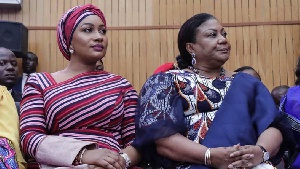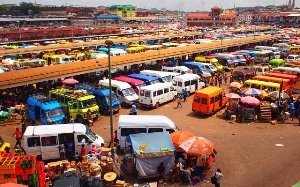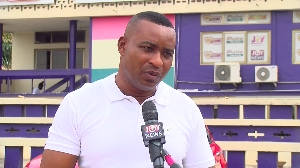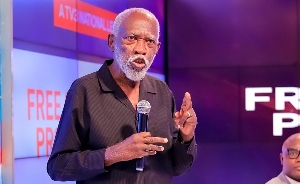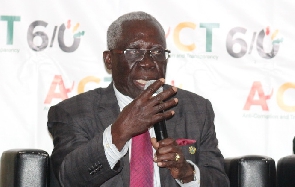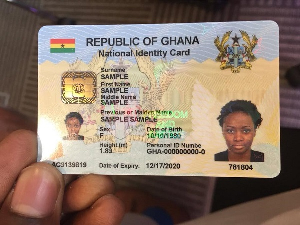The story so far:
Amanfuo, Ghana is labelled by international financial institutions as ?poor?. Clich?s like ?dire?, ?abject?, crippling, blinding, extreme etc have been used to depict the extent and depth of this canker. Yet we wallow in the most abundant of resources.
Amanfuo, I am no sceptic of economic reasoning, neither do I have any grudge against the subject or the people who benefit from it as a profession. It is just the blasphemous way in which it is being used that irritates me. We have what is perceived as a serious problem. It has defied all solutions. This gives ammunition to writers like George Bernard Shaw argued that ?If all economists were laid end to end, they would not reach a conclusion? Poverty is a prisoner of proportionality. Every society has its fair share of poverty and richness. But is our categorisation justifiable.
All sorts of measuring tools, or indicators as they are popularly called, have been employed in their crudest form to justify this horrible tag. Indeed our own economists and their government reports have been presented at international conferences to support this picture. In the end, as if that was not enough, they created another classification, the Heavily Indebted Poor Countries and attached certain sweeteners in the form of debt forgiveness for countries that buried their shame and pride, owned up and joined in. The NPP government, being as hungry as the general population, and dying to impress more that it?s predecessors went ahead without hesitation and applied for this nanankansiwa of all poverty tags.
The implications are now becoming clear. When you say you are poor, no one takes you seriously. The ?rich? trample on your rights with impunity. Your house can be ?invaded? anytime without notice or inhibition under the pretext of putting it in order. You can be given the bitter pill of quinine even when you have no fever. Your children can be attacked and insulted with ease. Migrated citizens of a ?poor? country can suffer all sorts of abuses, insults, discrimination and even death because their country of origin is considered poor and resource less and therefore powerless. Amanfuo, when the poor person speaks, no one listens.
In fact the situation is so bad that many foreign embassies in Ghana base their visa refusal reasons on the ?poor economic status ? of the country. That your country is so poor that when we give you the visa and you go, you will not want to come back even when the temperature drops to ?1000oc and everyone is running from the place.
Amanfuo, the problem I have is whether this self imposed and externally manufactured poverty status is true or let?s say right. As I discovered, there is no universally accepted definition of poverty. It is dependent on whom you ask, where and under what circumstances. They use concepts like ?poverty line?, income per capita / person in $, level of development etc, but are these relevant to our unique African or Ghanaian situation?
Amanfuo, for instance, they say that the per capita income is $ 100 per year for Ghana, yet there are millions of Ghanaians with incomes averaging $1000 per year. If this was false, how come someone living in a ?poor? country is able to support his alomo in a ?rich? country (the USA to be precise) to the wapping tune of $10, 000 a month!. So, is it the nation state that is poor or its citizenry or both? We shall find out.
Amanfuo, last week I received two mails from 2 prominent professors of economics working with two very reputable global financial institutions. Their problem? That I should tone down my ?expose? on the poverty question as it was making it difficult for them to justify and source funds for their current poverty reduction projects in Ghana and Africa. My reply is until we all get to the bottom of this wonderful and disturbing phenomenon, there will be no sleep for anyone connected with its creation or management.
Amanfuo, I have had to postpone writing this article about 70 times, but I can now conveniently go ahead with it, ehmmmmm some will say, the sermon on the rooftop, without the fear of raffling any political or economic feathers as the government has claimed or about to claim all the HIPC benefits due.
Amanfuo, if we were that deprived and poor, we will be doing the right things politically, economically, socially etc. Just look at these facts;
- We import the latest and expensive cars around the globe year in year out for our government officials / party functionaries etc with some costing as much as $90,000. Some top officials have three to four such cars. And if you have to judge that against the 60 or so ministers of state, not to talk of departmental heads, then we are talking about a colossal sum of money down the calabash. The people who work so hard to produce the revenue generating materials, the farmers etc do not get rewarded with even the basic tools of trade but cheap items like lanterns on the so called farmers day.
- Most years that the production of gold, cocoa and other non-traditional exports go up in quantity and revenue terms, we still claim the nation is broke. - We spend billions on importing arms etc for the security of the state yet a good proportion of the citizenry have no peace or go to bed at night on empty stomachs. - We have lately received billions in debt relief and another forms of aid, yet we still hear the ?P? word.
Amanfuo, it was in the midst of all this confusion which made me journey to sikaman to establish the true facts with my specially designed poverty measuring tool known as the ?ohiameter? (ohia ?poverty) and meter (measuring tool).
Amanfuo my invention is very dependable, user-friendly, precise, expansive, easy to carry and oooh copyrighted. It has an in-built camera to record real time information and by this I mean facts. It also has a thermostat to gauge the degree of poverty at all levels within selected geographical areas or populations, with green for non-existent poverty, yellow for just about and red for the dangerous form of poverty - what the west refers to as below $1 a day.
Amanfuo, I do not want to bore you before I have started, but this meter has an analyser that is clean, modern and free of errors or bias. It also selects where required the most representative population sample, and where wholesale nationwide coverage is problematic, it opts for the best of the actual segment or target group. Ohiameter is programmed to compare the local indicators with that of a selected rich country and score it over 10. At the end of the assignment, all the scores will be extracted and a total mark derived to determine whether we are truly poor or not, and to what extent if at all.
The next question is what information will I be investigating or for better of a posh word researching, during my journey to sikaman? Amanfuo, the main ohia indicators per population are comprehensively listed below;
- The spread of electricity per square mile and availability of clean water per population.
- The number of new cars per square mile
- The spread of banking facilities
- The number of children selling in the street
- The total population per square mile
- The number of efficiently - run state ?owned enterprises
- The number of ?productive? industries
- The number of people per household
- The number of ?stores?
- The number of actively employed
- The number of posh houses against dilapidated houses
- The degree of human congestion in the capital cities or towns
- The number of meals per person per 24 hours
- The average life spans
- The average costs of funerals
- The number of public holidays
- The number of ?chop bars?
- The number of political appointees per population
- The length and quality of the road network
- The level of workforce productivity
- The number of educational institutions / quality
- The availability of health care facilities / quality
- The extent and efficiency of the Social security system
- Number of areas / population with social amenities - toilets
- The number of people who board trotro versus taxis vs. government / private transport system
- The level of teenage pregnancy
- The cost of foodstuffs
- The general costs of living
- The level of pension payments
- Number of relevant development projects
- Number of people ?nicely? dressed
- Conduct of public officials
- The prison numbers per population
- The number of corrupt ministers jailed for causing financial loses to the state per population
- The number of homeless people
- The number of ethnic conflicts
- The amount of foreign travels by government ministers versus benefits accrued
- Domestic versus imported goods (choko milo)
- Level of savings / micro credit facilities
- The level of illiteracy or literacy
- The Cost of petrol
- The number of number of people trying to emigrate
- The number of road accidents
- The police to population ratio
- Quality of security / peace
- Quality and spread of telecommunications
- The levels of pollution
- Quality of products on sale
- The prevalence of corruption in public circles
- The doctor / nurse ? patient ration
- The number of maternal deaths
- The efficiency of the legal system
- The extent of environmental degradation
- Number of shops / stores
- Sanitation (rubbish dumps, gutters, public toilets)
- Extent of indigenisation of the economy
- Levels of incomes and / or income inequalities
- Level of debt of the nation
- The level of state pensions
- The Per capita income
- The number of NGO?s
- The percentage of the population that drinks ogogolo / palm wine versus beer
- The percentage of football supporters per population
Amanfuo, there are many others which may not be relevant to this trip. Now you tell me if there is any tool as comprehensive and solid as mine. That is why the professors of economics and financiers will soon be ripping off their suits and hairs.
Electricity spread:
Amanfuo, the use of electricity to determine how developed a country is very narrow and my friends at the IMF agree with me. We have therefore decided to incorporate less sophisticated ones like charcoal, kerosene, boomboom nkannea use, and firewood as opposed to just the white goods. The ECG could not give me an exact number, national or regional wise who use electricity, as they claim not to know precisely where most of their electricity lines went or ended up.
It was going to take them years to come up with the figures, which could have impacted on the quality of my research, so I negotiated a deal which will see me trying another reliable method with my ohiameter. From an unlikely but feasible source ? the air. Amanfuo, my first measurement of poverty thus started from the air.
Amanfuo, to do a proper research you need to ensure that all the influencing or relevant variables are present in their best constituents within a given time period. I therefore kindly ?begged? the ECG to turn on all the lights throughout the land on this day in question, which they kindly obliged. I was lucky because, the norm has always been to switch the electricity grid on and off without any warning or regard for what this could do to peoples electrical gadgets.
I boarded a Ghana bound flight and specifically requested for a window seat. The flight path was over Mali, Burkina Faso, the northern part of Ghana and then the ultimate destination, the Makola airport (where is this airport? I will tell you later!).
My gismo recorded patchy areas with limited lights around the northern sector. Below me on the ground I recorded the wide spread use of the Boomboom kanea, firewood etc as against electricity bulbs. The proportion altered as we approached mid Ghana where my meter recorded more electric bulbs than boomboom gya.
The capital Accra had a high percentage of bulbs and a negligible amount of boomboom kanea. Even so, in all the regional capitals, the electricity spread tended to be concentrated at the centre, with pitch darkness around the periphery.
Amanfuo, credit must be given where it is due - a pat on the back of the NDC for initiating this wonderful electrification projects which has dampened a bit of the deprivation.
So on the question of electricity spread, my ohiameter scored 3/10 for Ghana as against 10/10 in the developed world. Not too bad for a country with it?s own electricity generating dam.
Amanfuo, my plane finally taxied to its final destination ? the Makola airport. I can see many people wondering whether there is an airport at Makola. Of course there is ? the Rawlings park. Got you!!!!!!!
Why did I request for a drop off at this wonderful ?airport?? To measure my next variable ? The percentage of people that board trotro versus taxis. You see New York has more taxis and a good government subsidised transport network. This will therefore spice up my analysis as I make comparisons to determine our poverty status.
Amanfuo, I will end here and hope to continue from where I left off. God bless Ghana, God bless Africa and all those working day and night against our imaginary or real foe ? poverty.


